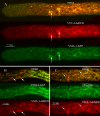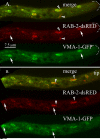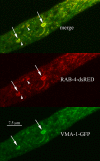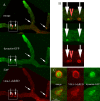Characterization of a Novel Prevacuolar Compartment in Neurospora crassa
- PMID: 26453652
- PMCID: PMC4664880
- DOI: 10.1128/EC.00128-15
Characterization of a Novel Prevacuolar Compartment in Neurospora crassa
Abstract
Using confocal microscopy, we observed ring-like organelles, similar in size to nuclei, in the hyphal tip of the filamentous fungus Neurospora crassa. These organelles contained a subset of vacuolar proteins. We hypothesize that they are novel prevacuolar compartments (PVCs). We examined the locations of several vacuolar enzymes and of fluorescent compounds that target the vacuole. Vacuolar membrane proteins, such as the vacuolar ATPase (VMA-1) and the polyphosphate polymerase (VTC-4), were observed in the PVCs. A pigment produced by adenine auxotrophs, used to visualize vacuoles, also accumulated in PVCs. Soluble enzymes of the vacuolar lumen, alkaline phosphatase and carboxypeptidase Y, were not observed in PVCs. The fluorescent molecule Oregon Green 488 carboxylic acid diacetate, succinimidyl ester (carboxy-DFFDA) accumulated in vacuoles and in a subset of PVCs, suggesting maturation of PVCs from the tip to distal regions. Three of the nine Rab GTPases in N. crassa, RAB-2, RAB-4, and RAB-7, localized to the PVCs. RAB-2 and RAB-4, which have similar amino acid sequences, are present in filamentous fungi but not in yeasts, and no function has previously been reported for these Rab GTPases in fungi. PVCs are highly pleomorphic, producing tubular projections that subsequently become detached. Dynein and dynactin formed globular clusters enclosed inside the lumen of PVCs. The size, structure, dynamic behavior, and protein composition of the PVCs appear to be significantly different from those of the well-studied prevacuolar compartment of yeasts.
Copyright © 2015, American Society for Microbiology. All Rights Reserved.
Figures










Similar articles
-
The structure of prevacuolar compartments in Neurospora crassa as observed with super-resolution microscopy.PLoS One. 2023 Apr 24;18(4):e0282989. doi: 10.1371/journal.pone.0282989. eCollection 2023. PLoS One. 2023. PMID: 37093794 Free PMC article.
-
Structure and distribution of organelles and cellular location of calcium transporters in Neurospora crassa.Eukaryot Cell. 2009 Dec;8(12):1845-55. doi: 10.1128/EC.00174-09. Epub 2009 Oct 2. Eukaryot Cell. 2009. PMID: 19801418 Free PMC article.
-
Null mutants of the neurospora actin-related protein 1 pointed-end complex show distinct phenotypes.Mol Biol Cell. 2001 Jul;12(7):2195-206. doi: 10.1091/mbc.12.7.2195. Mol Biol Cell. 2001. PMID: 11452013 Free PMC article.
-
Biogenesis of Plant Prevacuolar Multivesicular Bodies.Mol Plant. 2016 Jun 6;9(6):774-86. doi: 10.1016/j.molp.2016.01.011. Epub 2016 Feb 2. Mol Plant. 2016. PMID: 26836198 Review.
-
Plant prevacuolar/endosomal compartments.Int Rev Cytol. 2006;253:95-129. doi: 10.1016/S0074-7696(06)53003-7. Int Rev Cytol. 2006. PMID: 17098055 Review.
Cited by
-
The structure of prevacuolar compartments in Neurospora crassa as observed with super-resolution microscopy.PLoS One. 2023 Apr 24;18(4):e0282989. doi: 10.1371/journal.pone.0282989. eCollection 2023. PLoS One. 2023. PMID: 37093794 Free PMC article.
-
Chemotropism and Cell Fusion in Neurospora crassa Relies on the Formation of Distinct Protein Complexes by HAM-5 and a Novel Protein HAM-14.Genetics. 2016 May;203(1):319-34. doi: 10.1534/genetics.115.185348. Epub 2016 Mar 30. Genetics. 2016. PMID: 27029735 Free PMC article.
-
Off the wall: The rhyme and reason of Neurospora crassa hyphal morphogenesis.Cell Surf. 2019 Mar 8;5:100020. doi: 10.1016/j.tcsw.2019.100020. eCollection 2019 Dec. Cell Surf. 2019. PMID: 32743136 Free PMC article. Review.
-
Neurospora crassa NADPH Oxidase NOX-1 Is Localized in the Vacuolar System and the Plasma Membrane.Front Microbiol. 2019 Aug 14;10:1825. doi: 10.3389/fmicb.2019.01825. eCollection 2019. Front Microbiol. 2019. PMID: 31474947 Free PMC article.
-
Permissiveness and competition within and between Neurospora crassa syncytia.Genetics. 2023 Aug 9;224(4):iyad112. doi: 10.1093/genetics/iyad112. Genetics. 2023. PMID: 37313736 Free PMC article.
References
-
- Bowman EJ, Bowman BJ. 2010. Vacuoles in filamentous fungi, p 179–190. In Borkovich K, Ebbole DJ (ed), Cellular and molecular biology of filamentous fungi. ASM Press, Washington, DC.
-
- Richards A, Veses V, Gow NAR. 2010. Vacuole dynamics in fungi. Fungal Biol Rev 24:93–105. doi:10.1016/j.fbr.2010.04.002. - DOI
Publication types
MeSH terms
Substances
Grants and funding
LinkOut - more resources
Full Text Sources
Molecular Biology Databases

